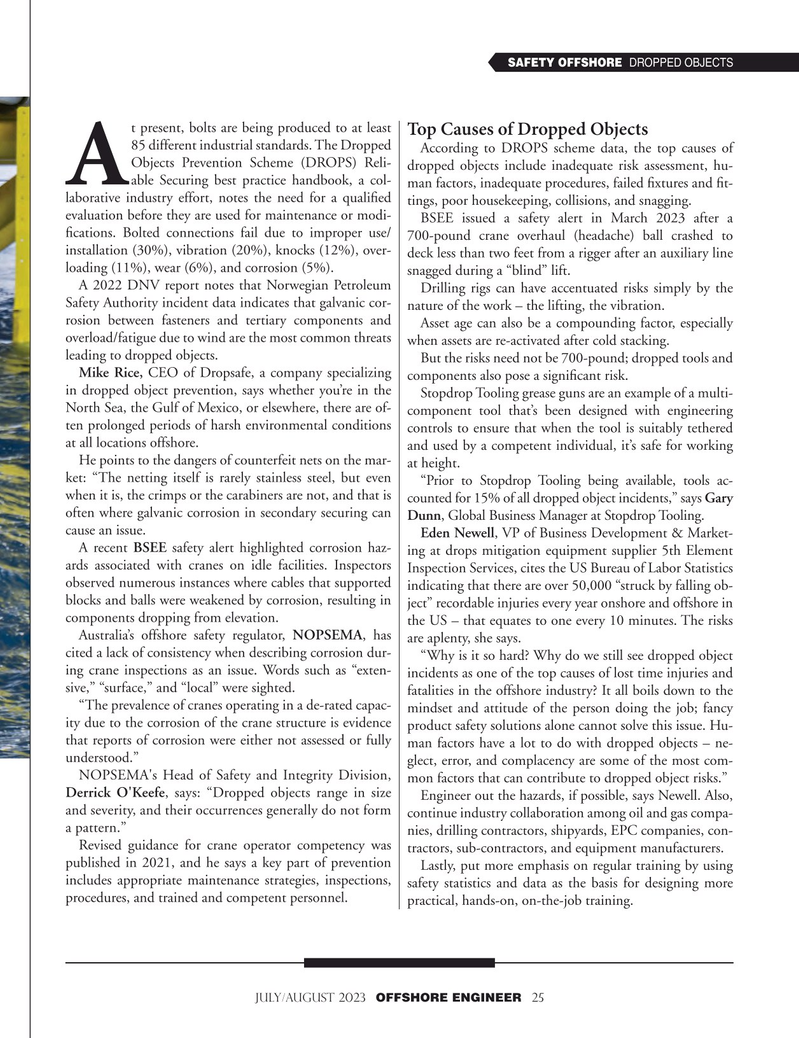
Page 25: of Offshore Engineer Magazine (Jul/Aug 2023)
Read this page in Pdf, Flash or Html5 edition of Jul/Aug 2023 Offshore Engineer Magazine
SAFETY OFFSHORE DROPPED OBJECTS t present, bolts are being produced to at least
Top Causes of Dropped Objects 85 different industrial standards. The Dropped
According to DROPS scheme data, the top causes of
Objects Prevention Scheme (DROPS) Reli- dropped objects include inadequate risk assessment, hu-
A able Securing best practice handbook, a col- man factors, inadequate procedures, failed fxtures and ft- laborative industry effort, notes the need for a qualifed tings, poor housekeeping, collisions, and snagging.
evaluation before they are used for maintenance or modi-
BSEE issued a safety alert in March 2023 after a fcations. Bolted connections fail due to improper use/ 700-pound crane overhaul (headache) ball crashed to installation (30%), vibration (20%), knocks (12%), over- deck less than two feet from a rigger after an auxiliary line loading (11%), wear (6%), and corrosion (5%).
snagged during a “blind” lift.
A 2022 DNV report notes that Norwegian Petroleum
Drilling rigs can have accentuated risks simply by the
Safety Authority incident data indicates that galvanic cor- nature of the work – the lifting, the vibration.
rosion between fasteners and tertiary components and
Asset age can also be a compounding factor, especially overload/fatigue due to wind are the most common threats when assets are re-activated after cold stacking.
leading to dropped objects.
But the risks need not be 700-pound; dropped tools and
Mike Rice, CEO of Dropsafe, a company specializing components also pose a signifcant risk.
in dropped object prevention, says whether you’re in the
Stopdrop Tooling grease guns are an example of a multi-
North Sea, the Gulf of Mexico, or elsewhere, there are of- component tool that’s been designed with engineering ten prolonged periods of harsh environmental conditions controls to ensure that when the tool is suitably tethered at all locations offshore.
and used by a competent individual, it’s safe for working
He points to the dangers of counterfeit nets on the mar- at height.
ket: “The netting itself is rarely stainless steel, but even “Prior to Stopdrop Tooling being available, tools ac- when it is, the crimps or the carabiners are not, and that is counted for 15% of all dropped object incidents,” says Gary often where galvanic corrosion in secondary securing can Dunn, Global Business Manager at Stopdrop Tooling.
cause an issue.
Eden N ewell, VP of Business Development & Market-
A recent BSEE safety alert highlighted corrosion haz- ing at drops mitigation equipment supplier 5th Element ards associated with cranes on idle facilities. Inspectors Inspection Services, cites the US Bureau of Labor Statistics observed numerous instances where cables that supported indicating that there are over 50,000 “struck by falling ob- blocks and balls were weakened by corrosion, resulting in ject” recordable injuries every year onshore and offshore in components dropping from elevation.
the US – that equates to one every 10 minutes. The risks
Australia’s offshore safety regulator, NOPSEMA, has are aplenty, she says.
cited a lack of consistency when describing corrosion dur- “Why is it so hard? Why do we still see dropped object ing crane inspections as an issue. Words such as “exten- incidents as one of the top causes of lost time injuries and sive,” “surface,” and “local” were sighted.
fatalities in the offshore industry? It all boils down to the “The prevalence of cranes operating in a de-rated capac- mindset and attitude of the person doing the job; fancy ity due to the corrosion of the crane structure is evidence product safety solutions alone cannot solve this issue. Hu- that reports of corrosion were either not assessed or fully man factors have a lot to do with dropped objects – ne- understood.” glect, error, and complacency are some of the most com-
NOPSEMA's Head of Safety and Integrity Division, mon factors that can contribute to dropped object risks.”
Derrick O'Keefe, says: “Dropped objects range in size
Engineer out the hazards, if possible, says Newell. Also, and severity, and their occurrences generally do not form continue industry collaboration among oil and gas compa- a pattern.” nies, drilling contractors, shipyards, EPC companies, con-
Revised guidance for crane operator competency was tractors, sub-contractors, and equipment manufacturers.
published in 2021, and he says a key part of prevention
Lastly, put more emphasis on regular training by using includes appropriate maintenance strategies, inspections, safety statistics and data as the basis for designing more procedures, and trained and competent personnel.
practical, hands-on, on-the-job training.
july/august 2023 OFFSHORE ENGINEER 25

 24
24

 26
26